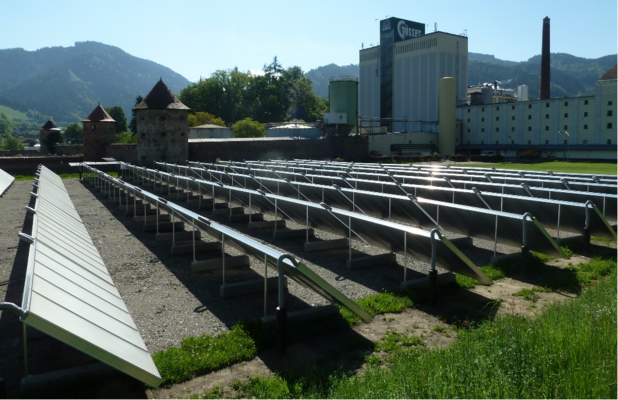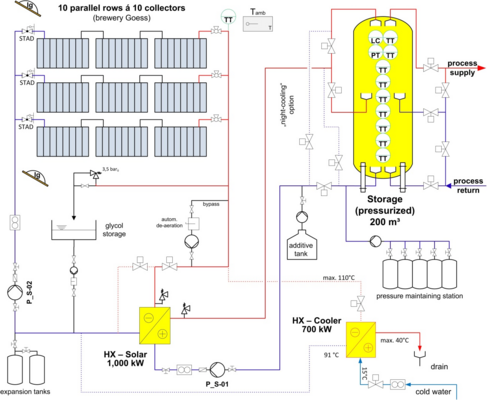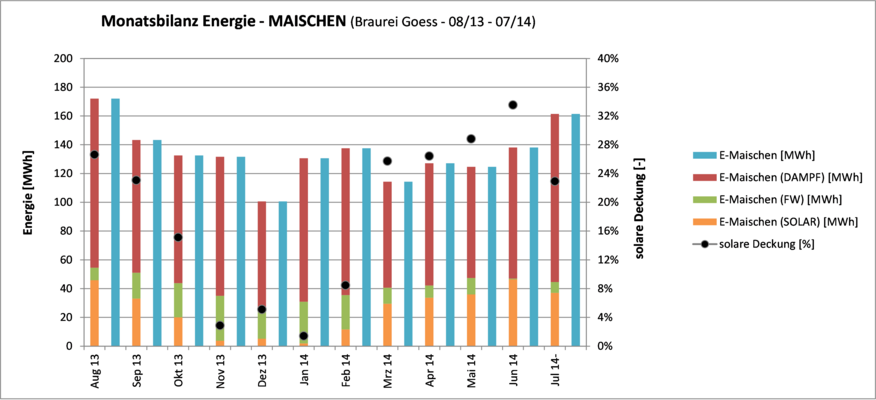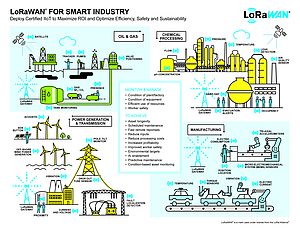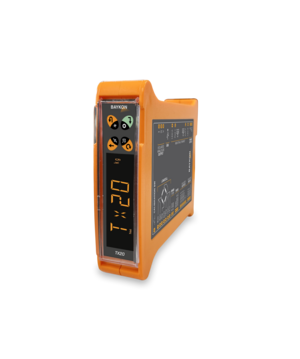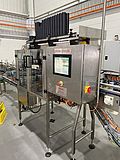Challenges
The manufacture of malt and beer requires large amounts of electrical and thermal energy which is nowadays mainly based on fossil fuels. In State of the Art breweries 7.5-11.5 kWhel and 60-120 MJth per hl of beer are needed and the annual output of medium to large sized breweries may easily exceed one million hl. The entire process heat demand of the thermally driven processes in breweries and malting plants can be met with heat at a temperature of between 25 and 105°C on process level. This enables the integration of solar thermal energy supplied by conventional, non-concentrating solar thermal collector technologies such as flat-plate or evacuated tube collectors.
In fact, providing thermal energy by means of solar thermal systems is mostly energy efficient if the energy from the sun is converted into heat and supplied to the process at minimum required temperature level. Against this background, the demonstration of the technical and economic feasibility of the integration of a large scale solar thermal system to the mashing process of the Austrian brewery Goess was initiated and a solar process heat application with a gross collector area of 1,500m² connected to a 200m³ energy storage tank was finally commissioned in June 2013.
Main features of the project
The project "SolarBrew" is coordinated by the Austrian research institute AEE INTEC and financed by Heineken Supply Chain B.V. to which the brewery Goess belongs. Funding is provided by the European Commission (FP7) as well as by the Austrian Klima- und Energiefonds. In order to meet the holistic approach, the Goess consortium was complemented by a process engineering partner (GEA Brewery Systems GmbH) as well as by the Danish solar thermal collector manufacturer and turn-key supplier of large-scale solar thermal systems Sunmark A/S.
Solar assisted mashing process for the brewery Goess
Since June 2013 a large-scale solar-thermal plant provides the Styrian brewery Goess with process heat and reduces the production-related CO2 emissions at the brewery in the range of 92 tonnes of CO2,equiv. per year.
The solar thermal system designed for the brewery Goess implies several innovative approaches: Two steam supplied vessels (mash tuns) were retrofitted by especially designed internal plate heat exchanger templates which enable a supply system based on hot water instead of steam. The new hot water supply is fed by waste heat from a nearby biomass CHP plant as well as by a large scale ground mounted solar thermal system (100 collectors summing up to a total of 1,500 m² gross collector area) which is hydraulically connected to a 200 m³ pressurized solar energy storage tank.
While mashing, the temperature of the mash is continuously increased from a starting temperature of around 58°C to a final temperature of around 78°. If there is solar thermal energy at the right temperature available the energy is taken out from the solar energy storage tank and pumped to the retrofitted plate heat exchangers. The return flow from the process back to the storage is stratified according to the temperature. If the temperature in the solar energy storage is not high enough but at least some °C higher than the process return temperature the process supply temperature needed is heated up in-line via the waste heat from the biomass CHP plant. In case the temperature in the energy storage tank is lower than the process return flow temperature the storage is bypassed and the mash tuns are fed by waste heat only. In case both systems cannot supply either the temperature or the energy quantity needed the existing steam supply system acts as backup in parallel. In Figure 3 the hydraulic scheme of the solar primary, secondary and cooling loop as well as the hydraulic integration of the solar energy storage is shown. From this pressurized hot water tank the energy from the sun is transported either directly to the mash tuns or further heated up via district heat.
Results
The performance of the solar thermal process heat system in Goess in operation mode (sunshine and heat demand) was in the first year of operation unproblematic. The specific solar gross heat output (measured by the solar primary circuit: E-Solar primary) were satisfactory with 527 MWh and 383 kWh/ (m²Apertur • a), taking into account the moderate solar radiation at the site and the high average collector working temperature of 87 °C and were as projected/simulated.
The annual sum of the radiation on the inclined collector surface (38 degrees) was 1,209 kWh/ (m²Apertur • a) in the measurement year. The solar circuit utilization rate for the year was 32%. The actual delivered useful solar energy (distribution and storage losses and losses due to night cooling: E-mashing SOLAR) was significantly lower with 304 MWh and 221 kWh/ (m²Apertur •a). The efficiency of the overall system was 18% (Figure 4) in the measurement year 2013/2014.
The high losses were due to long downtimes of the solar system. The mashing process operated only four (rarely five) days per week. Therefore often excess solar energy had to be actively cooled on the weekends during night. A total of 25% of the solar energy in energy storage was released back into the environment by means of night cooling via the collector field. A further 18% of the losses are due to heat losses of the energy storage and the piping system (solar + distribution process).
Based on the total thermal energy demand for the mashing process in the measurement year 1,614 MWh the solar fraction was approximately 19% or 304 MWh. 12% (193 MWh) were supplied by district heating and the majority (69% or 1,118 MWh) was heated by the existing steam heating (Figure 5). Here there is further need for improvement; a more extensive substitution of steam heating is the goal after the modifications of the mash tuns.
Reasons for the frequent heating with steam can be explained with the response time of the control system of the steam heating system. In addition, in some cases the delivered district heating flow-temperature for heating the mash tuns in the second and third heating step is not sufficient.
At the moment the control system is optimized for an optimized use of solar and district heating in combination with the steam heating. Additionally the process parameters will be adjusted (e.g. heating rates) so that the use of renewables can be increased in future.
Thus, the solar energy during the week can be used efficiently in the future. The second phase of construction was completed in August 2014. The second phase includes a further heat sink (production of brewing water and preheating of boiler feed water), where especially on weekends heat is needed and was hydraulically integrated into the overall system. In addition, the regulation of night cooling was optimized (adjusted speed control of the pumps at night cooling).
In the future it is planned to implement meteorological data for solar yield forecasts (for one to two days in advance) together with the energy storage charge level and the production capacity in an intelligent (predictive) control concept.
By DI Christoph Brunner, Head of Department Industrial Processes and Energy Systems, AEE - Institut für Nachhaltige Technologien, Germany


